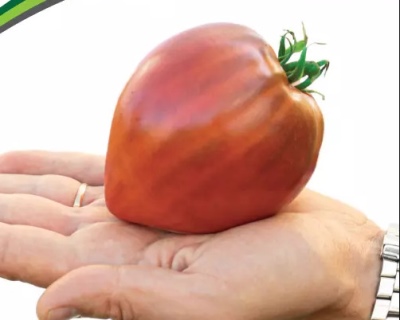
- Authors: V.I. Blokin-Mechtalin
- Year of approval: 2021
- Category: grade
- Growth type: indeterminate
- Appointment: fresh consumption
- Ripening period: mid-season
- Ripening time, days: 110-115
- Growing conditions: for film greenhouses, for closed ground, for greenhouses
- Bush size: tall
- Bush height, cm: 180
A breakthrough in garden culture can be recently bred plant varieties. But that is why it is necessary to study the information about them as carefully as possible. Now it's time to tell about just one such type - the Purple Heart tomatoes.
Breeding history
This is, indeed, a new variety. It was officially registered and allowed to be used in vegetable gardens in 2021. The developer of the culture is the well-proven Blokin-Mechtalin.
Description of the variety
Indeterminate development is typical for the Violet Heart. This will definitely delight many gardeners who are not afraid of fighting the ever-climbing shoots. The height of the bushes can reach 1.8 m. They are covered with green, moderately long foliage.
The main qualities of the fruit
Freshly formed berries are green. In the area of the stalk, a dark green spot is necessarily formed. When ripe, tomatoes acquire a purple-red hue. In shape, these large berries really look like a heart. Their average weight is 270 g.
It is also worth considering that the Purple Heart:
slightly ribbed;
formed from complex inflorescences;
the first inflorescence is laid over 6 or 7 leaves;
the next inflorescences will be created every 2 leaves;
differs in an articulated version of the stalk.
Taste characteristics
The pulp of this variety is sweet. It is worth emphasizing its inherent fleshiness. The density of the tomato is moderate. There are not too many nests in it, which means a relatively small effect of seeds on the final taste balance.
Ripening and fruiting
The purple heart belongs to mid-season tomatoes. This crop will usually delight farmers with its berries 110-115 days after the formation of early green shoots. But sometimes weather conditions significantly shift this period. Up to 10 tomatoes can appear in one brush.
Yield
The productivity level of this variety is extremely high. It can be up to 18 kg per 1 sq. m. However, much depends on the conditions in which this culture is. And how much they will take care of her. According to some reports, the productivity in protected ground conditions can be up to 25 kg of berries.
The timing of planting seedlings and planting in the ground
A number of gardeners emphasize that mid-season varieties should be planted in sync with early varieties. Since in the available sources the timing of planting seeds and transshipment into the ground is bypassed, this recommendation can be followed. In any case, it is necessary to assess the condition of the plants themselves and the garden or greenhouse soil. It is worth considering that in some materials the planting of seeds in March or April is still mentioned.

Growing tomato seedlings is an extremely important process, because it largely depends on whether the gardener will be able to harvest at all. All aspects must be taken into account, from seedbed preparation to planting in the ground.
Landing scheme
Recommended placement on a 400x700 mm system. The highest permissible planting density is 3 bushes per 1 sq. m.Attempts to exceed it will definitely not lead to anything good.

Growing and care
You cannot do without tying up the bushes and their strictly defined formation. Formation of 1 or 2 stems is typical. The first option allows you to get larger fruits. In the second case, they will not be so large, but in a larger number. All brushes must be tied up.
This variety is considered resistant to the whole range of common diseases. But in an unfavorable environment and massive infections of plants, preventive treatments are still necessary. The lack of sufficiently deep recommendations on agricultural technology for this particular variety forces us to build on common proven techniques. Watering tomatoes must be active, but without fanaticism.
Weeding is carried out after moistening the earth. It is advisable to combine it with soil loosening. Mulching is carried out as needed according to the standard method. Top dressing is carried out 3 or 4 times per season. It is necessary to weed the bushes regularly.




A plant needs different micronutrients at each stage of growth. All fertilizers can be divided into two groups: mineral and organic. Folk remedies are often used: iodine, yeast, bird droppings, eggshells.
It is important to observe the rate and period of feeding. This also applies to folk remedies and organic fertilizers.


Growing regions
The Purple Heart tomato is able to express itself in:
Western Siberia;
conditions of East Siberian and Far Eastern vegetable gardens;
Middle and Lower Volga region;
practically the entire European part of Russia, except for the regions of the Far North;
Ural and North Caucasian landings.

























































































